Almost everyone I know who collects board games toys with the idea of creating their own. I have been playing around with the mechanics of games since I was a kid. Much to the annoyance of my family, I was constantly changing the rules or using the game pieces to create my own game. Even though my family couldn’t understand it, I was experimenting to improve games we often played. Could I make the games more fun? Or even make my own game? Fast forward to today, and I own over 100 board games (or nearly 200 depending on how you count). So when an opportunity came up to design my own game, I had to take it.
The opening occurred during a meeting with our Education and Engagement Manager Laura Forde and Anna Killian, then-site supervisor for the Chateau de Morès State Historic Site. At the time, we were planning a teacher workshop at the Chateau focusing on the 1880s cattle boom. The first thing that came to mind was a premise for a game. I shared it with the group—initially pitching it as a cattle roundup activity—and it made the list. Now I just needed to design the game.
The concept was simple. Make a game based on the children’s card-matching game Memory where you hunt for the cattle that match your brand in a herd. That basic idea was a good start, but I needed to flesh it out a bit more. I thought about what other concepts I would want to convey to my students besides what is a roundup. My list came out as follows:
- Law and order
- Rustling
- The economics of cattle
- Math
As I started thinking about the game mechanics needed to capture these ideas, the biggest challenge appeared to be having too many ideas. I had several ways that I could handle rustling, but which would be best? Playtesting would be needed to answer that question. So I took a couple of days to draft some rules. Writing these rules was the most challenging part, as I had to devise a way to put them on paper so that non-gamers could easily understand them. Once my rules were drafted, the next step was to build a prototype.
There is a surprising amount of math that goes into designing a game. I needed to figure out how many cards to make. It was like solving a dreaded story problem in a math textbook. If the game consists of three rounds, and during each round the players must find four cows to sell, how many cows must each initial herd contain? The answer was 16. To work in the economics of raising cattle, I wanted to find a way to represent the fact that you want to sell cattle in their prime. Players would need to sell the cattle at the right time to get top dollar. If they sell too early or too late the cow would be worth less money. For the game, I represented a year as a round of play. Each round, the players try and find the four best cows to sell. I also had to figure out the different dollar amounts for each cow card and ensure the spread was even among the three rounds. I also worked in a turn counter so that if the players took too many turns trying to find their cattle they would incur a penalty. Now they have an economic choice to either pay the penalty or sell a subprime cow. Once I knew the number of cards needed, I used Photoshop to make quick designs. I spent the next two days cutting out the cards and sliding them into plastic sleeves, placing a playing card between the front and back card to provide stability. Once assembled, I had six full-sized herds and two sets of rules to test.
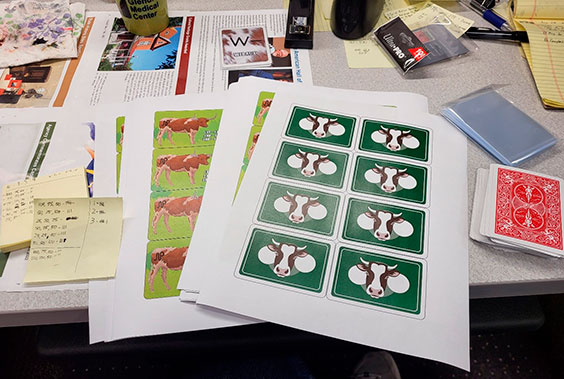
A pile of cards waits to be cut out and sleeved. Also visible are the Post-It notes used to figure out my card numbers.
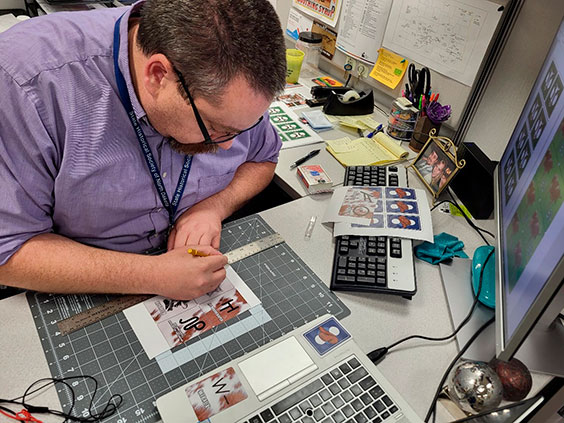
Unfortunately, I spaced the cards too close together to feel comfortable using a paper cutter. As a result, I had to cut out all the cards by hand.
My original plan was to have our certified interpretive gallery guide, Tom Chase, test the game with visitors to the North Dakota Heritage Center & State Museum. I taught him and another interpretive gallery guide, Kristi Carpenter, how to play one afternoon. Though they never had time to try it with guests, playing with them taught me a few things. For example, six players would be too many. Running out of time, I recruited my wife’s family (my usual game group) to spend an afternoon playing the game several times so that I could test the rules. We had a lot of fun, and I got the answers that I needed to my rules-related questions.
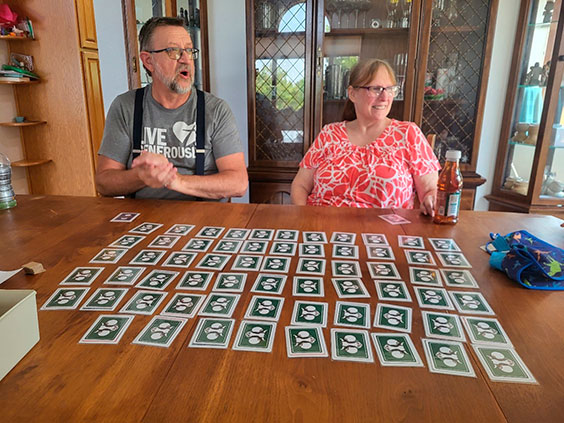
Family members Brian and Roxanne Rosin helped me playtest the game and gave valuable insights, such as to make sure the playing cards all had the same backside next time. That design flaw may have given them an unfair advantage during the initial testing phase.
Equipped with my final designs, I had the cards printed just in time for our workshop in Medora. Watching the teachers play the game was fun. Many responded that they enjoyed the game and thought their students would also love it. Being teachers, they quickly picked up on the historical themes. I even had one teacher say that they would love to use it for their economics class. Based on feedback, I will make a few simple changes before sending them the design files and final rules so they can make their own copies of the game.
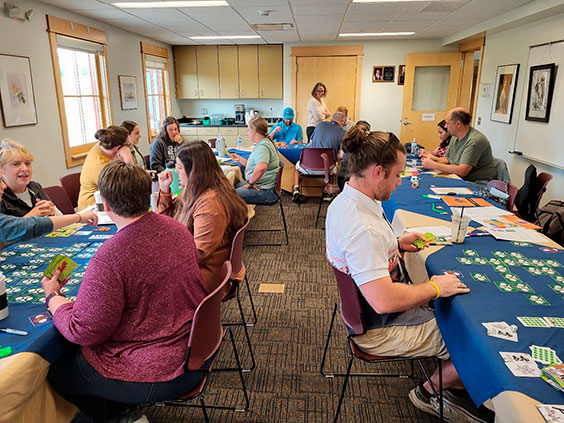
Teachers play the game as part of our North Dakota Studies teacher workshop at the Chateau de Morès State Historic Site.

This game was only one of many lessons and activities workshop attendees experienced and were able to bring back to their class.
So now that the game exists, what is next? Well, there is some interest in the State Historical Society of North Dakota turning this game into a sellable product. It is currently going through the editors, who are waiting for me to review their suggestions and questions while I write this blog post. We will also work with our new media specialists to improve my Photoshop work. Maybe one day you will be able to buy a copy for yourself. As for me, as much fun as this process has been, I think I will put my budding game design career on hold for the foreseeable future and spend a bit more time playing games with my family.

My wife, Kate, gets some help from our daughter, Auri.
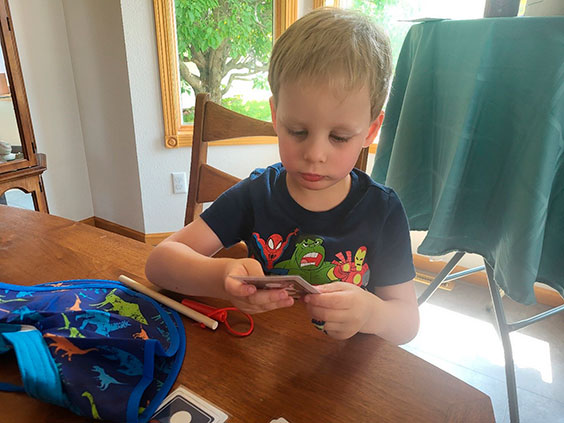
My son, Calvin, checks to see whether a cow matches our brand.

